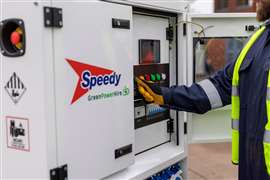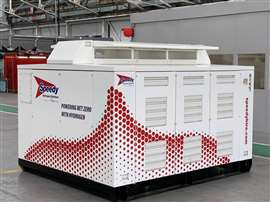Speedy Hire Online Summit: 2025 is time for energy transition
14 January 2025
Construction firms in the United Kingdom are expected to take more action to advance their energy transition plans in 2025 as they now have more clean energy solutions to choose from than a few years ago.
Construction contractors could tackle the cost and availability issues step-by-step when shifting towards new energy equipment, a group of energy and rental experts said in the Speedy Hire Live Sustainability Summit 2024.
“Over the last couple of years, companies have shown higher interest and made a lot more investment in the energy transition,” said Michael Sheffield, commercial director at AFC Energy, a developer of hydrogen fuel cell technologies. “The challenge is moving from talking about it and doing sustainability studies to actually doing it.”
“More customers have signed up for the Science Based Targets initiative (SBTi), where they have those milestones to hit annually,” added Mike DeRome, head of fuel at Speedy Hire. “There is an absolute need to start transitioning towards something different from diesel to produce lower carbon emissions.”
He said companies can now begin the energy transition using the right equipment, fuel and solutions. He said, for example, a construction site can turn its power generator off for 12 to 13 hours daily and use its battery storage unit to maintain emergency and security lighting at night.
“Cost is always the thing that stops the energy transition from moving forward. If HVO (hydrotreated vegetable oil) and diesel were both at the same price, everybody would go for the HVO option. But they are not,” he added.
 Energy transition experts say data collection is the first step in making measurable progress in decarbonisation. (Photo: Speedy Hire)
Energy transition experts say data collection is the first step in making measurable progress in decarbonisation. (Photo: Speedy Hire)
What is HVO?
HVO is a biofuel that can reduce carbon dioxide emissions by around 90% and be used as a replacement for fossil diesel.
The current fuel duty rate for diesel is 52.95 pence (€0.63) per litre (ppl). Marked gas oil or red diesel is taxed at 10.18 ppl for off-road use.
However, since April 2022, using red diesel in cranes, bulldozers, or mobile generators on construction sites has become illegal.
The duty is 10.18 ppl only if HVO is being used to replace red diesel in a setting that allows the use of red diesel. Otherwise, it is 52.95 ppl.
“There was some hope that the HVO or GTL (gas-to-liquid) would enjoy a lower duty rate in the future,” DeRome said.
“There is quite a lot of lobbying happening…that’s the one thing I think would have a massive swing. Because when you bring that price down to parity, the decision is a no-brainer.”
Net zero targets
Between 1990 and 2021, the UK cut its emissions by 48%, decarbonising faster than any other G7 country, whilst growing the economy by 65%, according to the UK government.
In 2019, the UK became the first major economy in the world to legislate to reach net zero emissions with a binding target by 2050. According to the Climate Change Act 2008, the legal definition of net zero is to ensure that the “net UK carbon account” is 100% lower than the 1990 baseline.
Energy transition experts said equipment rental firms and construction companies should determine how to collect the data before contributing to the UK’s net zero plan.
“If you are burning alternative fuels but not collecting and monitoring the data, what are you proving?” said Sheffield. “All modern technology now has telematics capability. Utilising that is the best part for tracking fuel and carbon emissions reductions.”
“It is sometimes quite difficult to explain to the end customer, just by saying that this solution is going to help you burn less fuel and reduce your carbon emissions,” said Dan Thompson, managing director at Speedy Hire’s Power and Energy division. “Unless you can prove that a customer is saving more on the fuel spent after paying more for a battery, energy transition can be a difficult conversation to have.”
“It’s not ever going to be a one-size-fits-all situation. Battery is a great technology from a small-tool perspective, but if you are looking at bigger pieces of construction equipment or heavy goods vehicles, is battery necessarily going to be the right thing over the long term?” he said.
“There are many different ways we can get to net zero,” noted James Cadman, head of Consultancy & Climate, Action Sustainability at Supply Chain Sustainability School.
 An AFC Energy fuel cell genset in the colours of rental partner Speedy Hydrogen Solutions (Photo: AFC Energy)
An AFC Energy fuel cell genset in the colours of rental partner Speedy Hydrogen Solutions (Photo: AFC Energy)
“If everyone was all going for the same technology and the same kind of equipment, there’s a restriction in the marketplace where everyone is scrambling for that technology,” he said. “We have a bit of diversity in that sense. There’s no one silver bullet.”
Hydrogen and ethanol
Hydrogen and ethanol are now among the most popular fuels used to replace fossil diesel.
Hydrogen can be produced from natural gas or biomass and used to generate electricity in combustion engines or fuel cells.
Bioethanol is produced from biomass, such as plant starches and sugars, through fermentation, while synthetic ethanol is made from fossil raw materials.
“There’s always a challenge around infrastructure… where can you get the new fuel from? How to store it? You have got to get all the jigsaw pieces in place earlier to make it work,” Thompson said.
“One of those things people are hesitant about is hydrogen safety. There is always a stigma with the word ‘hydrogen’...we need to get away from that,” Sheffield said. “I’ve seen a lot of news saying that the UK’s hydrogen availability is not great. It’s a challenge that we have here. And I’ve seen in the new government that there has been a lot of investment in creating hydrogen. That’s going to help a lot.”
In August 2021, the UK government said it aimed for 10 gigawatts of low-carbon hydrogen production capacity by 2030 for use across the economy, with at least half of this coming from electrolytic hydrogen.
In October 2024, the Labour government’s budget confirmed £2 billion of funding for 11 green hydrogen projects with a total capacity of 125 megawatts.
“We are at the start of the hydrogen journey from a power perspective. You need someone who’s going to be bold to take the product on in the first place and bring it to market early,” Thompson said. “But then you definitely need clients and customers that are willing to be bold as well and take a little bit of a risk.”
“We’re talking about risk appetite here for trying new stuff and moving away from being conservative,” Cadman said.
He said the construction industry hopes the government will take the lead by investing in trial programs and demonstrating them so others will have the confidence to replicate them later. He said energy transition is a “chicken and egg” matter, requiring the collaboration between the government and industry players.
Driving decarbonisation
In September 2023, then-UK Prime Minister Rishi Sunak announced that the deadline for phasing out the sale of new internal combustion engine (ICE) cars using petrol, diesel, liquid petroleum gas, and hybrid vehicles had been delayed from 2030 to 2035.
The Labour Party, which defeated the governing Conservative Party in the general election in July 2024, is mulling reinstating the 2030 ban on ICE cars to give automakers certainty about the UK’s energy transition plan. It may allow the sales of some new hybrid cars until 2035.
 Niftylift’s hydrogen-powered access platform (Photo: Speedy Hire, Niftylift)
Niftylift’s hydrogen-powered access platform (Photo: Speedy Hire, Niftylift)
In the Speedy Hire Sustainability Summit, energy transition experts also shared their views on how to encourage drivers to use hybrid electric vehicles (HEVs) and light electric commercial vehicles (LCVs).
“Drivers are very hesitant to go into an EV because they could be driving an ICE vehicle for 20 years. It’s a whole change in how they did things,” said Kris Parkes, fleet manager at Speedy Hire. “But once they are in it, they have a much nicer driving experience. It’s good for the drivers to get in those vehicles and just experience them.”
“We’re just trying to educate people: here’s your journey, let’s pre-plan a little bit. You can always rock up to a fuel station with an ICE car, and you can also do that with an EV, just with a little bit more forethought.”
He said companies can help drivers overcome their “range anxiety” by providing information to plan their journeys.
“It’s charge anxiety with a lot of people, rather than range anxiety. People know they can make the journey, but they are not sure whether they can find a charger on the way that’s not being used,” Aaron Powell, fleet director at Speedy Hire, said, adding that many EVs now have an average range of 300 to 400 miles per charge.
“It was quite a good thing to put the most anti-EV driver into an EV,” Powell said. “We had an engineer who was adamant to drive an EV. But he finally did it. And within a couple of days, he rang up and said ‘This is fantastic’. He is now a good advocate for everybody who said ‘I can’t drive one’.”
He said many grid companies are focusing on the commercial side of the UK’s energy transition by building more rapid charging points.
According to Zapmap, an EV charging points map, there were 73,699 EV charging points across the UK at the end of December 2024. Only one in five, or 14,471, were rapid (50kW to 149kW) or ultra-rapid (150kW+) charging devices, which can take as short as 30 minutes to complete a full charge.
The remaining were mainly charging devices under 8kW, which take five to 11 hours to charge an EV fully.
STAY CONNECTED



Receive the information you need when you need it through our world-leading magazines, newsletters and daily briefings.
CONNECT WITH THE TEAM






